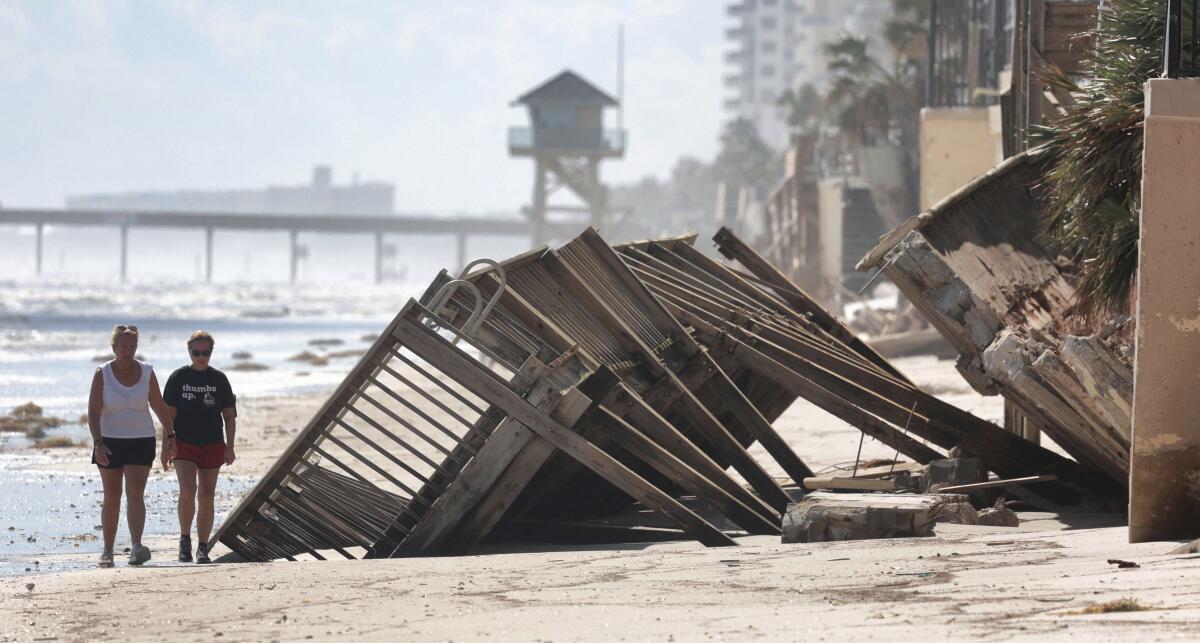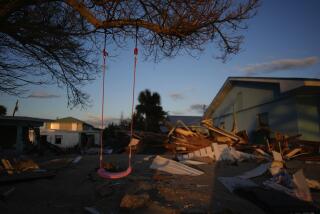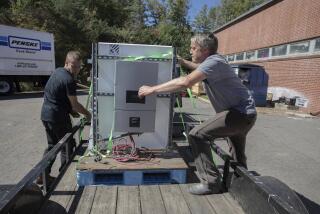Frustration and desperation mount as Ian’s effects linger

- Share via
FORT MYERS, Fla. — Days after the skies cleared and the winds died down in Florida, Hurricane Ian’s effects persisted Monday, as some people faced another week without power and others were being rescued from homes inundated with lingering floodwaters.
Ten additional deaths in Florida were blamed on the storm, as frustration and desperation mounted.
And the hurricane’s remnants, now a nor’easter, aren’t done. The mid-Atlantic and Northeast coasts were getting flooding rains Monday. The storm’s onshore winds piled even more water into an already inundated Chesapeake Bay.
Norfolk and Virginia Beach, Va., declared states of emergency, although a shift in wind direction prevented potentially catastrophic levels, said Cody Poche, a meteorologist with the National Weather Service in Wakefield, Va.
Coastal flooding shut down the only highway to part of North Carolina’s Outer Banks, and flooding was possible all the way to Long Island, the National Weather Service said.
At least 78 people have been confirmed dead: 71 in Florida, four in North Carolina and three in Cuba. Ian made landfall on the Caribbean island Tuesday and in Florida a day later.
Search and rescue efforts were ongoing Monday in Florida. More than 1,600 people had been rescued statewide, according to Florida’s emergency management agency.
Ray Murphy, mayor of Fort Myers Beach, Fla., told NBC’s “Today” that most residents who had evacuated were being kept away from their homes because of searches that are likely to last a few more days.
Washed-out bridges to barrier islands, flooded roadways, spotty cellphone service and a lack of water, electricity and internet left hundreds of thousands of people isolated. The situation in many areas isn’t expected to improve for several days because waterways are overflowing, leaving the rain that fell with nowhere to go.
In DeSoto County, northeast of Fort Myers, the Peace River and tributaries reached record high levels, and boats were the only way to get supplies to many of the 37,000 residents.
The county was prepared for strong winds after being hit by Hurricane Charley in 2004, but it was not prepared for so much rainfall, which amounted to a year’s worth of precipitation in two days, DeSoto County Commissioner J.C. Deriso said.
“This flood has been pretty catastrophic,” said Deriso, adding that officials hope to open one of the area’s main highways by Tuesday.
Joe Gunn said the first two days without power at his Punta Gorda, Fla., home weren’t bad because he and his wife and 4-year-old daughter like to camp.
But then they ran out of gas, Gunn said, as he waited an hour for $20 worth of premium fuel from a Bonita Springs station, one of the few open in the area. The family then drove to get supplies and a hot meal.
Gunn was preparing for another stressful night, worried that someone might try to steal his supplies.
“I am constantly listening to the generator. It’s pitch black outside of the house,” he said.
Across southwest Florida, residents whose homes were overrun by the sea or floods threw waterlogged mattresses, couches and other belongings into the street and tore out floors and cut into walls, hoping to dry the shells of their houses before mold set in.
“Everything that got water is starting to mold. We’re cutting all the drywall out, two feet up, trying to get things dried out to save the house and to protect it from more damage,” said Jeff Rioux, who was thankful for several days of nice weather and generators to run fans.
Neighbors helped each other where they could.
“I lost everything,” said Alice Pujols, crying as she picked through heaps of castaway clothes at a stranger’s home. “I’m just looking for what I can salvage.”
About 550,000 homes and businesses in Florida were without electricity Monday morning, down from a peak of 2.6 million. But that is still nearly the same amount of customers in all of Rhode Island.
The current goal is to restore power by Sunday to customers whose power lines and other electric infrastructure are intact, Florida Division of Emergency Management Director Kevin Guthrie said Monday.
President Biden and First Lady Jill Biden plan to visit Florida on Wednesday. The president was in Puerto Rico on Monday, promising to “rebuild it all” after Hurricane Fiona knocked out all power to the island two weeks ago.
In Virginia, the U.S. Navy postponed the deployment of the U.S.S. Gerald R. Ford, the nation’s most advanced aircraft carrier, according to a statement from the Navy’s 2nd Fleet. The carrier and other U.S. ships were scheduled to leave Norfolk on Monday for training exercises in the Atlantic Ocean with vessels from other NATO countries.
Coast Guard, municipal and private crews have been using helicopters, boats and even Jet Skis to evacuate people over the past several days.
After moving across Florida, Ian made landfall in South Carolina as a much weaker hurricane. Officials there said Monday that crews were finishing removing sand from coastal roads, and nearly all power had been restored.
Associated Press reporters Anthony Izaguirre in Tallahassee, Fla.; Frieda Frisaro and David Fischer in Miami; Ben Finley in Norfolk; and Jeffrey Collins in Columbia, S.C., contributed to this report.
More to Read
Sign up for Essential California
The most important California stories and recommendations in your inbox every morning.
You may occasionally receive promotional content from the Los Angeles Times.










